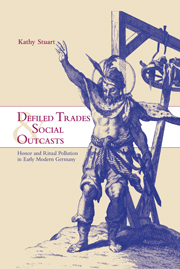Book contents
- Frontmatter
- Contents
- List of illustrations
- Acknowledgments
- List of abbreviations
- Glossary
- Introduction: defiled trades
- PART I THE MEANING OF DISHONOR IN EARLY MODERN SOCIETY
- 1 Medieval versus early modern dishonor
- 2 Honor, status, and pollution
- PART II THE DISHONORABLE MILIEU
- PART III PARADOXICAL DISHONOR: PUNISHMENT AND HEALING
- PART IV ARTISANAL HONOR AND URBAN POLITICS
- Conclusion: dishonor and the society of orders
- Selected bibliography
- Index
- CAMBRIDGE STUDIES IN EARLY MODERN HISTORY
1 - Medieval versus early modern dishonor
Published online by Cambridge University Press: 06 August 2009
- Frontmatter
- Contents
- List of illustrations
- Acknowledgments
- List of abbreviations
- Glossary
- Introduction: defiled trades
- PART I THE MEANING OF DISHONOR IN EARLY MODERN SOCIETY
- 1 Medieval versus early modern dishonor
- 2 Honor, status, and pollution
- PART II THE DISHONORABLE MILIEU
- PART III PARADOXICAL DISHONOR: PUNISHMENT AND HEALING
- PART IV ARTISANAL HONOR AND URBAN POLITICS
- Conclusion: dishonor and the society of orders
- Selected bibliography
- Index
- CAMBRIDGE STUDIES IN EARLY MODERN HISTORY
Summary
We begin with a brief discussion of the legal history of dishonor in the empire in the high and late middle ages. Prescriptive legal sources will serve as a foil against which to project the social history of dishonorable people in the early modern period. Medieval Germanic conceptions of dishonor were recorded in high medieval Germanic law books, such as the Mirror of the Saxons (Sachsenspiegel), written around 1224, or the Mirror of the Swabians (Schwabenspiegel), written around 1275 in Augsburg. These law books were unofficial private compilations, which claimed to record old law and custom rather than to create new law. The mirrors listed the Wergeld to which members of the different social orders were entitled in cases of accidental death and thus reflected and codified the social hierarchy. At the same time, they defined which groups fell outside of this social order. Both mirrors listed a variety of groups who were dishonorable to differing degrees. Wandering minstrels and professional fighters, who performed for an audience or represented the old, the disabled, or women in trial by combat, were considered contemptible due to their profession. They were described as taking goods for honor, indeed as giving up their personhood for money (spilleuten und allen den die gut fur ere nemen und die sich zu eigen haben gegeben). The dishonor of professional fighters (Kempen) extended to their children.
- Type
- Chapter
- Information
- Defiled Trades and Social OutcastsHonor and Ritual Pollution in Early Modern Germany, pp. 23 - 32Publisher: Cambridge University PressPrint publication year: 2000

